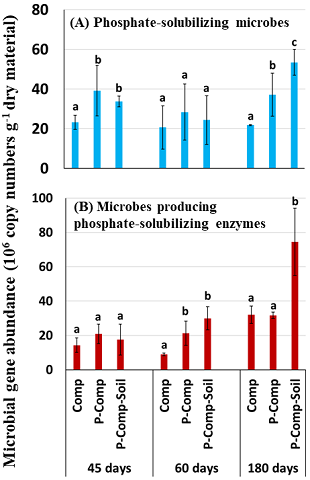Effect of rhizosphere soil addition on available phosphorus content in phosphate rock-enriched compost
Description
The available phosphorus (P) content in sub-Saharan African soils is limited, representing a major constraint on agricultural productivity. Phosphoric fertilizers are used to correct soil phosphorus deficiency, but their high costs have prevented widespread adoption by African smallholder farmers. Phosphate rock, the primary material for manufacturing phosphoric fertilizer, is found in considerable quantities in several African countries, including Burkina Faso. Burkina Faso Phosphate Rock (BPR) is often co-composted with crop residues to enhance P availability through biological processes. Microbial materials are often used to promote P solubilization during the composting process, but it is difficult for many African farmers to obtain commercially available microbial inoculants. Here, we investigated alternative and smallholder farmer-friendly ways of improving P solubilization during composting by supplementing composts with rhizosphere soil as a microorganism source.In this study, we prepared and monitored three compost types, sole compost, BPR-enriched compost, BPR-enriched compost + rhizosphere soil, for 180 days (Fig. 1). The C/N ratio was adjusted to 25/1 with urea, and the moisture content was maintained at 65% with regular watering. We examined the changes in available P fractions and the dynamics of P-solubilizing microbes, as well as the release of enzymes associated with P solubilization. At compost maturity (180 days), the combined number of P-solubilizing microbes (P-solubilizing bacteria = PSB and P-solubilizing fungi = PSF) in BPR-enriched composts was significantly higher in the treatment supplemented with rhizosphere soil (Fig. 2A). At this stage, the number of microbes producing P-solubilizing enzymes was also significantly higher in the BPR-enriched compost with soil (Fig. 2B). Among these microbes, those producing the alkaline phosphatase enzyme (phoD) were exponentially higher than those that release acid phosphatase and phosphonatase (data not shown). The available phosphorus in composts significantly correlated with P-solubilizing fungi and alkaline phosphatase that dominate the microbes and the enzymes, respectively (Fig. 3). We observed no positive correlation between phosphate-solubilizing bacteria (PSB) and available P. The available phosphorus content (inorganic and organic phosphorus extracted with sodium hydrogen carbonate and water) in the BPR-rock-enriched compost was equivalent until the 60th day after the start of the composting. However, on the 180th day, although the difference was not significant, the available phosphorus content of the compost with the rhizosphere soil tended to be higher than when it was not added (Fig. 4). This result indicates that rhizosphere soil is a promising microbial consortium source to promote phosphorus solubilization during the composting process.
We confirmed through sorghum field trials that BPR-enriched compost with rhizosphere soil leads to yields equivalent to that of chemical fertilizer (NPK).
Figure, table
-
Fig. 1. Composting trial
-
Fig. 2. Changes in the abundance of phosphate-solubilizing microbes and phosphate-solubilizing enzymes during composting
(A) Phosphate-solubilizing microbes = phosphate-solubilizing fungi + phosphate-solubilizing bacteria, (B) Phosphate-solubilizing enzyme-producing microbes = alkaline phosphatase-producing + acid phosphatase-producing + phosphonatase-producing microbes. Alphabets that differ in each sampling period show a significant difference at p<0.05 by one-way ANOVA.
-
Fig. 3. Relationships between the amount of available phosphorus and microbial gene abundance during composting
●PSF: phosphate-solubilizing fungi, ●phoD: alkaline phosphatase-producing microbes,
●PSB: phosphate-solubilizing bacteria.
Sampling was performed on the 45th, 60th, and 180th day after the start of the composting. The data shown are the means for each type of compost over each period.
-
Fig. 4. Transition of available phosphorus fractions during composting
■NaHCO3_Po: sodium bicarbonate-extracted organic phosphorus,
■NaHCO3_Pi: Sodium hydrogen carbonate-extracted inorganic phosphorus,
■H2O_Po: water-extracted organic phosphorus,
■H2O_Pi: water-extracted inorganic phosphorus. At each period, different alphabets indicate a significant difference at p<0.05 following one-way ANOVA.
- Affiliation
-
Japan International Research Center for Agricultural Sciences Crop, Livestock and Environment Division
- Classification
-
Research
- Program name
- Research Project
-
establishment of the model for fertilizing cultivation promotion using Burkina Faso phosphate rock
- Term of research
-
FY2020(FY2017~FY2021)
- Responsible researcher
-
Sarr Papa Saliou ( Crop, Livestock and Environment Division )
ORCID ID0000-0002-4478-4463Nakamura Satoshi ( Crop, Livestock and Environment Division )
ORCID ID0000-0002-0952-5618KAKEN Researcher No.: 00749921Fukuda Monrawee ( Crop, Livestock and Environment Division )
Tibiri Ezechiel Bionimian ( Environmental Institute for Agricultural Research, Burkina Faso )
Zongo Armel Nongma ( Environmental Institute for Agricultural Research, Burkina Faso )
Compaore Emmanuel ( Environmental Institute for Agricultural Research, Burkina Faso )
- ほか
- Publication, etc.
-
Sarr PS et al. (2020) Frontiers in Environmental Sciencehttps://doi.org/10.3389/fenvs.2020.559195
- Japanese PDF
-
2020_A11_A4_ja.pdf612.37 KB
2020_A11_A3_ja.pdf611.84 KB
- English PDF
-
2020_A11_A4_en.pdf564.05 KB
2020_A11_A3_en.pdf565.27 KB
- Poster PDF
-
2020_A11_poster.pdf429.39 KB
* Affiliation at the time of implementation of the study.

